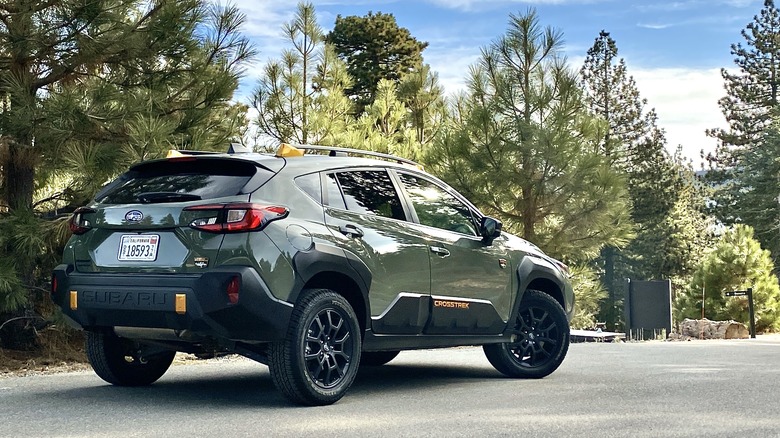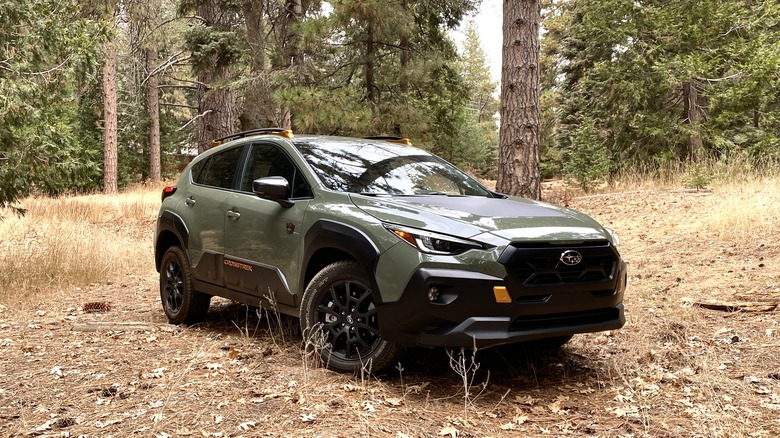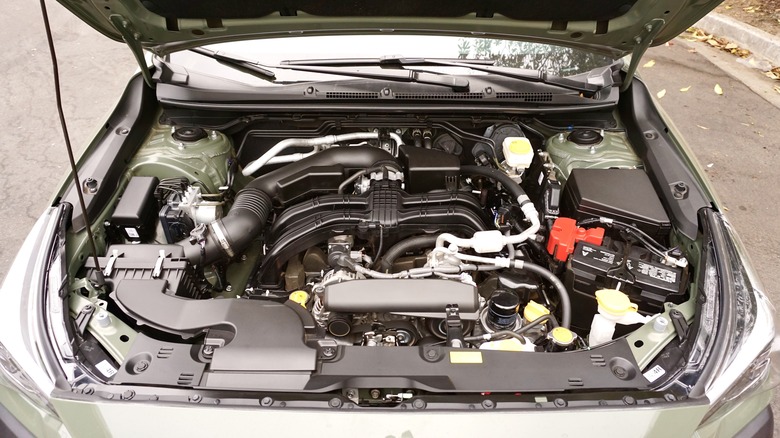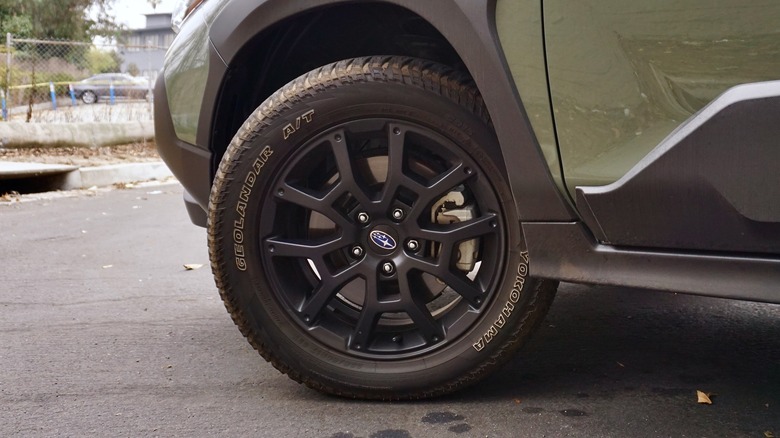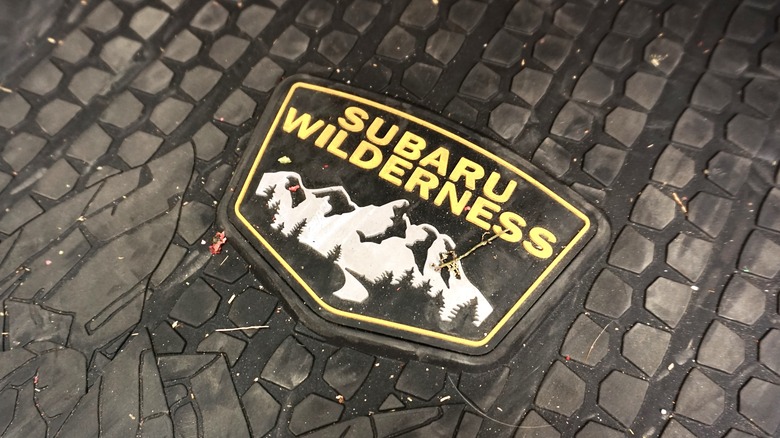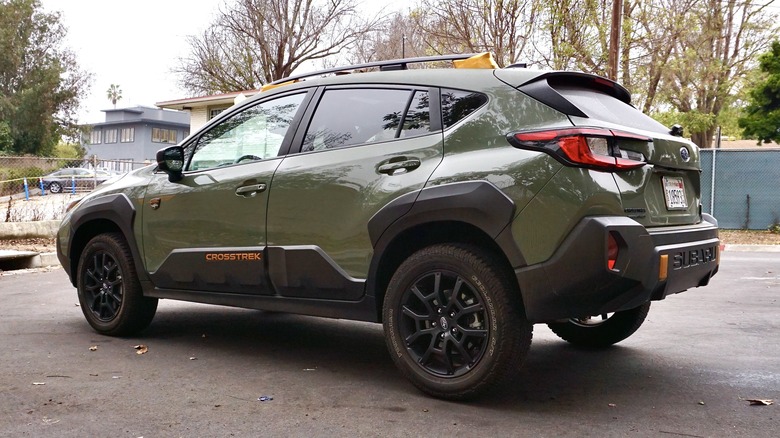Just How Tough Is The Subaru Crosstrek Wilderness & How Far Off-Road Can It Go?
Subaru vehicles are generally known for their strong all-weather and all-terrain performance. Subaru's most off-road ready models include old standbys like the Outback and Forester, both of which can handle inclement weather or rough roads. All-wheel drive is equipped as standard on pretty much all Subaru vehicles (with the exception of the rear-drive sports car, the BRZ) and that can be a crucial factor for all-weather traction. Even the sporty four-door sedan, the WRX, comes standard with all-wheel drive — a rare feature amongst compact sedans.
For some drivers though, that's not enough. Some nature explorers want to go where the roads are rough and the night sky isn't polluted by city light. All-wheel drive can get you pretty far, but when the going gets tough and extra capability is required, that's where Subaru's Wilderness models step in. The Subaru Crosstrek Wilderness is the most capable version of Subaru's compact SUV, with lifted ride height, hardware and software upgrades, and aesthetic differences that help set it apart from your everyday Crosstrek. But just how big is the gap between the standard Crosstrek and the Wilderness model? Is the latter as off-road capable as Subaru says it is?
The off-road stats that matter
Standard versions of the Crosstrek come with 8.7 inches of ground clearance, but the Wilderness model's hardware puts it at 9.3 inches of ground clearance. That extra space underneath changes the approach and departure angles significantly, as well as the breakover angle. Approach and departure angles, in basic terms, are the angles between your front and rear tires and your front and rear bumpers. The higher the approach or departure angle, the closer your tires can get to an obstacle without scraping the bumper.
Breakover angles are measured between the front and rear tires, and without going too far into detail, it's better to have a higher number in that department too. The higher your ride height, the higher your breakover angle and the less likely you are to get hung up (high-center) on rocks. The extra ground clearance the Wilderness gets translates into better numbers in all three measurements. Approach and departure angles increase from 18.0 to 20.0 and 30.1 to 33.0 degrees, respectively. The breakover angle goes from 19.7 to 21.1 degrees. All those measurements are pretty significant differences and likely enough to stop the Crosstrek Wilderness from getting held up on small rocks or steep surfaces that the standard model might otherwise be unable to overcome.
The Crosstrek Wilderness has a healthy engine and unique final drive
Base Subaru Crosstrek models use a 2.0-liter engine that makes 152 horsepower and 145 pound-feet of torque. Every other version of the Crosstrek (including the Wilderness) uses a 2.5-liter four-cylinder engine that produces 182 horsepower and 178 pound-feet of torque. While that isn't exactly a monstrous amount of power, it's a decent upgrade over the standard engine. The extra power makes the Wilderness trim much more likable as a daily driver and as an off-roader especially when you consider the trim-specific change in final-drive ratio. The Wilderness model goes from a 4.111 final drive to a 3.700 final drive for increased crawling capability — it's an addition that nobody will see on the outside of the car, but you'll appreciate it when tackling slow-speed obstacles.
The Crosstrek's standard 2.0-liter engine gets an EPA rating of 29 mpg combined (27 city/34 highway) and the upgraded 2.5-liter engine pays almost no penalty for the extra power, checking in at 29 mpg combined (27 city/33 highway). With the standard all-terrain tires and the taller ride height, the Crosstrek Wilderness drops to 27 mpg combined (25 city/29 highway). That's a bit lower than the standard model, but according to the EPA's estimates that's only $100 a year in added fuel cost (if you drive 15,000 miles annually). With that relatively small hit in fuel economy, the trade-off for the extra capability certainly seems worth it.
Tires do a lot of work when you're off-roading
Whether a vehicle has four-wheel drive or all-wheel drive can certainly contribute to its off-road capability. Locking differentials and disconnecting sway bars play a big role in off-road capability too. The Crosstrek is missing some of that serious off-road hardware, but the addition of all-terrain tires give it a leg up over some competitors. After all, you're not traversing the Rubicon Trail with summer high-performance tires, no matter how off-road ready your vehicle is.
Standard versions of the Crosstrek come with relatively common all-season tires which will maximize traction and fuel economy on the road, but for off-roading, you need something a bit more serious. The Yokohama Geolandar all-terrain tires that come standard on the Crosstrek Wilderness fill in that gap. They are a good example of a tire that's off-road capable, without beating you up on the highway ride home from your weekend adventure. All-terrain tires like the Geolandar add grip on surfaces like rocks and dirt, providing off-road traction when you need it most. And, as we saw above, they don't cost you much in terms of overall fuel economy. With a bit of added off-road capability, without sacrificing much in the way of traction or on-road noise, the Geolandar are the Goldilocks tires for the Crosstrek Wilderness – they're just right.
The little things make a difference
Part of what makes the Crosstrek Wilderness such a capable off-road performer is its ability to take a bit of abuse. From the black plastic cladding on the exterior to the weather-resistant upholstery and the all-weather floor mats, it feels ready to go on an adventure the moment you drive it home. The Crosstrek's tech gives it a boost off-road as well. The Wilderness version features Subaru's X-Mode system that adjusts performance to different road surfaces.
Subaru also rates its roof rack system in a way that's helpful to campers — letting you know that you can store 165 pounds of gear on top while the vehicle is in motion and 700 pounds when it's parked. Why the difference in rating? If you plan on adding a roof-top tent to your Crosstrek, you'll probably want to know just how heavy it can be and how many people can sleep in it when your vehicle is stationary. Subaru seems to have paid attention to the little details when putting this package together, and made the Wilderness edition into more than just a lifted version of the standard Crosstrek.
The Crosstrek WIlderness can tow up to 3,500 pounds
Small cars like the Subaru Crosstrek aren't exactly known for their towing capability; that's typically the territory of body-on-frame SUVs. When you upgrade a vehicle for better all-road performance though, some of those upgrades can translate into extra pulling power. That's certainly the case with the Crosstrek Wilderness. The standard Crosstrek is rated to pull a maximum of 1,500 lbs, but the Wilderness model gets an available transmission oil cooler which ups the capacity to 3,500 lbs.
To put that in practical terms, a 1,500-pound trailer is pretty small. Think of a small utility trailer with a bit of gear or a teardrop camper. The increase to 3,500 pounds means you're able to tow larger trailers that can fit more camping gear — potentially something enclosed and capable of housing some sleeping quarters like a family-sized camp trailer. This increase in towing capability doesn't directly translate to off-road capability, but the additional oil cooler is likely to help out when the going gets tough, so it's a win-win. Whether you're towing or not, it's pretty clear that the Crosstrek Wilderness has a lot to offer in the off-road department. It's a significant upgrade over the standard model and it has more than enough capability to go head-to-head with some of the best off-roaders out there.
